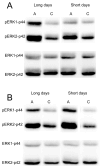Effects of photoperiod and experience on aggressive behavior in female California mice
- PMID: 20060017
- PMCID: PMC2831116
- DOI: 10.1016/j.bbr.2009.12.038
Effects of photoperiod and experience on aggressive behavior in female California mice
Abstract
Aggressive behavior among females is observed in many species, but the mechanisms of this behavior have historically been understudied. In many species of rodents, winter-like short day photoperiods induce increased aggression levels compared to summer-like long day photoperiods. Recent reports in hamsters show that short days also increase aggression in females. We examined the effects of photoperiod on aggression in female California mice, and for the first time compare brain activity of aggression-tested female rodents under different photoperiods. We observed that female California mice were more aggressive when housed in short days versus long days. Intriguingly, we also observed that under long days female attack latency decreases with repeated testing in resident-intruder tests. These data suggest that winner effects that have been described in males may also occur in females. We also used the expression of phosphorylated extracellular signal-regulated kinases (pERK) in the brain to estimate brain activity during aggression tests. pERK can alter neuronal activity in the short term and in the long term can act as a transcription factor. Using immunoblot analyses we observed that aggression-induced pERK expression in the female bed nucleus of the stria terminalis and medial amygdala occurs under both long and short days. Thus, the mechanisms controlling increased aggression under short days are still unclear and additional study is needed.
Copyright 2010 Elsevier B.V. All rights reserved.
Figures






References
-
- Abraham IM, Todman MG, Korach KS, Herbison AE. Critical in vivo roles for classical estrogen receptors in rapid estrogen actions on intracellular signaling in mouse brain. Endocrinology. 2004;145:3055–3061. - PubMed
-
- Beaugrand J, Goulet C, Payette D. Outcome of dyadic conflict in male green swordtail fish, Xiphophorus helleri: Effects of body size and prior dominance. Anim Behav. 1991:41.
-
- Becker JB, Arnold AP, Berkley KJ, Blaustein JD, Eckel LA, Hampson E, Herman JP, Marts S, Sadee W, Steiner M, et al. Strategies and Methods for Research on Sex Differences in Brain and Behavior. Endocrinology. 2005;146:1650–1673. - PubMed
-
- Blanchard RJ, Wall PM, Blanchard DC. Problems in the study of rodent aggression. Horm Behav. 2003;44:161–170. - PubMed
-
- Caldwell HK, Albers HE. Effects of photoperiod on vasopressin-induced aggression in Syrian hamsters. Horm Behav. 2004;46:444–449. - PubMed
Publication types
MeSH terms
Substances
Grants and funding
LinkOut - more resources
Full Text Sources

